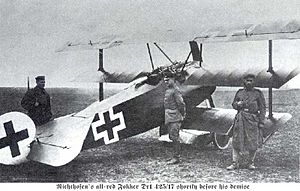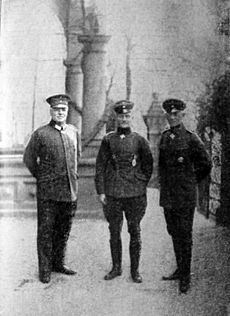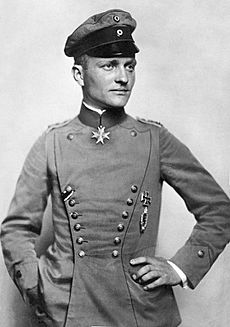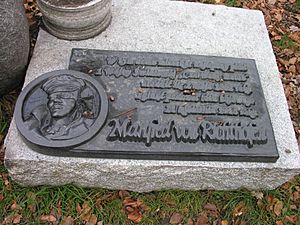Manfred von Richthofen facts for kids
Quick facts for kids
Manfred von Richthofen
|
|
|---|---|
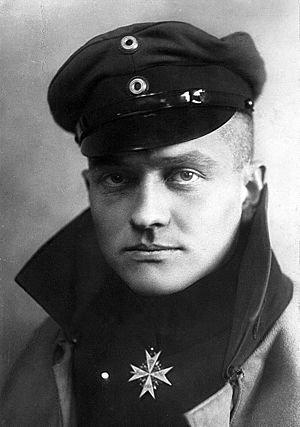
Richthofen wears the Pour le Mérite, the "Blue Max", Prussia's highest military order, in this official portrait, c. 1917.
|
|
| Birth name | Manfred Albrecht von Richthofen |
| Nickname(s) | "The Red Baron" |
| Born | 2 May 1892 Breslau, Prussia, German Empire (present-day Wrocław, Poland) |
| Died | 21 April 1918 (aged 25) Near Morlancourt, France |
| Place of burial | (50°3′36.94″N 8°15′56.92″E / 50.0602611°N 8.2658111°E) |
| Allegiance | |
| Service/ |
|
| Years of service | 1911–1918 |
| Rank | Captain |
| Commands held |
|
| Battles | |
| Awards |
|
| Signature | |
Manfred von Richthofen (born May 2, 1892 – died April 21, 1918) was a famous German fighter pilot during World War I. He is best known as the Red Baron. He was the top pilot of the war, officially shooting down 80 enemy planes.
Manfred started his military career in the cavalry. But in 1915, he joined the German Air Force, called the Luftstreitkräfte. He quickly became a skilled fighter pilot. In 1917, he became the leader of a fighter squadron called Jasta 11. Later, he led a larger group of fighter planes called Jagdgeschwader I. This group was nicknamed "The Flying Circus" because their planes were painted in bright colors. They also moved around a lot, like a traveling circus. By 1918, Richthofen was a national hero in Germany. Even his enemies respected him.
The Red Baron was shot down and killed on April 21, 1918, near Vaux-sur-Somme, France. He is still one of the most famous fighter pilots ever. Many books and movies have been made about him.
Who was the Red Baron?
Richthofen was a Freiherr, which is a German noble title similar to a "baron". This title was not just for him; all male members of his family could use it. He became known as the "Red Baron" because he painted his airplane bright red. This made him very easy to spot in the sky. In Germany, people often called him Der Rote Kampfflieger, which means "The Red Battle Flyer" or "The Red Fighter Pilot". This was even the title of his autobiography, written in 1917.
Manfred's early life
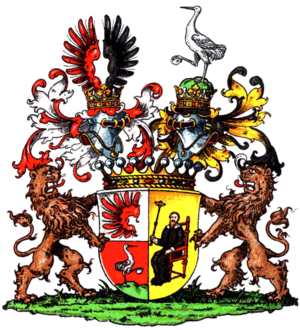
Manfred von Richthofen was born on May 2, 1892. He grew up in a wealthy family in Kleinburg, near Breslau, Germany (now part of Wrocław, Poland). His father was Major Albrecht Philipp Karl Julius Freiherr von Richthofen. Manfred had an older sister, Ilse, and two younger brothers, Lothar and Bolko.
When he was four, his family moved to Schweidnitz (now Świdnica, Poland). Manfred loved riding horses and hunting. He was also good at gymnastics at school. He and his brothers hunted wild boar, elk, and deer.
Manfred started military training when he was 11. In 1911, he joined a cavalry unit called the Uhlan Regiment.
Joining the Air Force
When World War I began, Richthofen first served as a cavalry officer. He rode horses to scout out enemy positions in Russia, France, and Belgium. But soon, trench warfare started. This made cavalry attacks useless. Richthofen's unit had to get off their horses and work as messengers. He was bored and disappointed because he couldn't fight directly.
He became interested in airplanes after seeing a German military aircraft. He asked to join the German Air Service. He famously wrote in his request, "I have not gone to war in order to collect cheese and eggs, but for another purpose." His request was approved, and he joined the flying service in May 1915.
From June to August 1915, Richthofen flew as an observer on scouting missions. He was later transferred to a flying unit in Belgium. There, his friend Georg Zeumer taught him how to fly a plane by himself.
Becoming a pilot
Manfred von Richthofen met a famous German pilot named Oswald Boelcke. This meeting inspired him to start pilot training in October 1915. In February 1916, Manfred convinced his brother Lothar to join the air force too. The next month, Manfred joined a bomber squadron. At first, he wasn't a very good pilot. He even crashed during his first flight! But he quickly learned how to control his plane.
He met Oswald Boelcke again in August 1916. Boelcke chose Richthofen to join his new fighter squadron, Jasta 2. This was one of the first German fighter squadrons. Sadly, Boelcke died in a mid-air crash in October 1916, and Richthofen saw it happen.
First victories
Richthofen got his first confirmed victory on September 17, 1916. He shot down a British plane over Cambrai, France. He later ordered a silver cup engraved with the date and the type of plane he shot down. He did this for each of his victories until he had 60 cups. After that, Germany ran out of silver because of the war.
His brother Lothar was a very aggressive pilot. But Manfred followed a set of rules called the "Dicta Boelcke" to win battles safely. He wasn't a flashy pilot, but he was a great planner and a very good shot. He would usually dive down from above, with the sun behind him, while other pilots in his squadron protected his sides and back.
On November 23, 1916, Richthofen shot down a very famous British pilot, Major Lanoe Hawker. Richthofen called Hawker "the British Boelcke." After this fight, Richthofen decided he needed a more agile fighter plane. He switched to the Albatros D.III in January 1917.
The Red Fokker Triplane
Richthofen started flying the famous Fokker Dr.I triplane in July 1917. This distinctive three-winged plane is what most people think of when they hear "Red Baron." However, he only got 19 of his 80 victories in this plane. His Albatros D.III was the first plane he painted bright red in January 1917. This is how he earned his famous name.
Richthofen also helped design the new Fokker D.VII plane. But he died before he ever got to fly it in combat.
The Flying Circus
In January 1917, after his 16th victory, Richthofen received the Pour le Mérite. This was Germany's highest military honor, also known as "The Blue Max." That same month, he took command of Jasta 11. This squadron included some of Germany's best pilots, many of whom he trained himself.
When Richthofen became a squadron commander, he decided to paint his Albatros plane red. He wrote, "For whatever reasons, one fine day I came upon the idea of having my crate painted glaring red." Other pilots in Jasta 11 started painting parts of their planes red too. This helped everyone recognize their unit. Soon, other German squadrons also started using their own bright colors.
Richthofen led his unit to amazing success, especially during "Bloody April" in 1917. In that month alone, he shot down 22 British planes. This brought his total victories to 52. By June, he was put in charge of a new, larger group of fighter squadrons called Jagdgeschwader 1. This group became known as "The Flying Circus" because of their colorful planes and how they moved quickly to different parts of the front.
Richthofen was a brilliant leader and planner. He taught his pilots a simple rule: "Aim for the man and don't miss him. If you are fighting a two-seater, get the observer first; until you have silenced the gun, don't bother about the pilot."
Wounded in combat
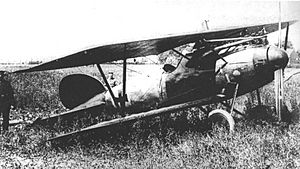
On July 6, 1917, Richthofen was seriously wounded in the head during a fight near Wervik, Belgium. The injury made him confused and temporarily blind. He managed to land his plane safely in friendly territory. He needed several operations to remove bone fragments from his head.
The Red Baron returned to flying on July 25, even though his doctors told him not to. He later took more time off to recover. His wound might have caused lasting problems. He often had headaches and felt sick after flying. Some people think this injury affected his judgment later on.
A national hero
While he was recovering, Richthofen wrote a short autobiography called Der rote Kampfflieger. The German Air Force asked him to write it for propaganda purposes.
By 1918, Richthofen was a huge legend in Germany. People worried that if he died, it would hurt the morale of the German people. But he refused to take a safer job on the ground. He believed he had to keep flying, just like every soldier in the trenches had to do their duty. German propaganda even spread false rumors that the British had special squadrons just to hunt him down.
The Red Baron's death
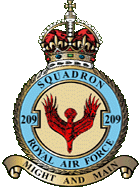
Manfred von Richthofen was killed just after 11:00 AM on April 21, 1918. He was flying very low over Morlancourt Ridge, near the Somme River in France. He was chasing a British Sopwith Camel plane flown by a Canadian pilot named Wop May. Richthofen had just saved his cousin, Lieutenant Wolfram von Richthofen, from May's attack.
As Richthofen chased May, another Canadian pilot, Captain Roy Brown, briefly attacked Richthofen. Richthofen turned to avoid Brown's attack, then continued chasing May. It was during this chase that a single bullet hit Richthofen through the chest. It severely damaged his heart and lungs, killing him in less than a minute.
His plane crashed in a field near Vaux-sur-Somme. Several witnesses found Richthofen already dead in his plane. His face was pressed against his machine guns, breaking his nose and jaw.
The Australian Flying Corps (AFC) was the closest Allied air unit. They took charge of Richthofen's body. His Fokker Dr.I plane was quickly taken apart by people looking for souvenirs.
In 2009, Richthofen's death certificate was found in Poland. It confirmed he died on April 21, 1918, from combat wounds.
Who shot him down?
For a long time, there was debate about who shot down the Red Baron. British pilot Captain Roy Brown was given credit for the kill. However, many historians now believe that Richthofen was actually killed by ground fire from Australian soldiers.
The bullet that killed Richthofen came from below and behind him. This suggests it was fired from the ground. Also, Captain Brown's plane was climbing steeply when he fired, making it unlikely he could have hit Richthofen from that angle.
The most likely person to have fired the fatal shot was Sergeant Cedric Popkin of the Australian Imperial Force. He was using a Vickers machine gun and fired at Richthofen's plane as it flew low over his position.
Why did he fly so low?
Richthofen was a very skilled pilot and knew the dangers of flying low over enemy lines. So why did he do it on his last flight?
One idea is that his head injury from July 1917 affected his brain. This could have made him less careful or caused him to focus too much on his target (May's plane). His behavior after the injury was similar to people with brain damage.
Another idea is that he was suffering from combat stress. This could have made him take risks he normally wouldn't.
Also, the wind that day was very strong and blowing from the east. This meant Richthofen was flying much faster over the ground than usual. He might not have realized how far he had flown into enemy territory.
Burial and legacy

Major David Blake, the commanding officer of No. 3 Squadron AFC, respected the Red Baron greatly. He arranged a full military funeral for him.
Richthofen was buried in the cemetery at Bertangles, France, on April 22, 1918. Six officers from No. 3 Squadron carried his coffin. Other Allied squadrons sent memorial wreaths, one of which said, "To Our Gallant and Worthy Foe."
Years later, in 1925, Richthofen's youngest brother, Bolko, moved his body to Germany. The family wanted him buried in Schweidnitz, next to his father and brother Lothar. But the German government asked for him to be buried in the Invalidenfriedhof Cemetery in Berlin, where many German military heroes were buried. The family agreed, and Richthofen received a state funeral. In 1975, his body was moved again to the Richthofen family grave in Wiesbaden, Germany.
How many victories?
For many years after World War I, some people doubted if Richthofen really had 80 victories. They thought his record was made up for propaganda.
However, Richthofen's victories are very well documented. A full list of the planes he was credited with shooting down was published in 1958. It included details like the enemy squadron, plane serial numbers, and what happened to the Allied airmen (killed or captured). Out of his 80 claimed victories, 73 match actual British losses. A study in 1998 also confirmed the accuracy of his claims. He might even have had more unconfirmed victories.
To compare, the top Allied pilot, Frenchman René Fonck, had 75 confirmed victories. The highest-scoring British Empire pilots were Canadian Billy Bishop (72 victories) and British Mick Mannock (61 victories).
Richthofen achieved many of his successes even when the enemy had more planes and often better ones than his own.
Awards and tributes
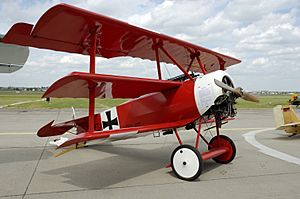
Awards and decorations
Manfred von Richthofen received many awards for his bravery and skill. Some of the most important ones include:
- Iron Cross, 1st and 2nd Class
- Pour le Mérite (The Blue Max), Germany's highest military honor
- Order of the Red Eagle
- House Order of Hohenzollern
- Wound Badge
He also received awards from other countries allied with Germany, like the Austro-Hungarian Empire, the Ottoman Empire, and Bulgaria.
Tributes
Several German military air units have been named after the Red Baron:
- Jagdgeschwader 132 "Richthofen" (1936–1938)
- Jagdgeschwader 131 "Richthofen" (1938–1939)
- Jagdgeschwader 2 "Richthofen" (1939–1945)
- Jagdgeschwader 71 "Richthofen" (since 1959) – this was the first jet-fighter unit of the modern German Air Force.
In 1968, Richthofen was added to the International Air & Space Hall of Fame.
Relics
Many parts of Richthofen's famous Fokker triplane were taken as souvenirs after his death.
- Captain Roy Brown, the pilot who was credited with shooting him down, donated the seat of Richthofen's plane to the Royal Canadian Military Institute in Toronto. This institute also has a side panel signed by the pilots of Brown's squadron.
- The engine of Richthofen's plane is on display at the Imperial War Museum in London. The museum also has his machine guns.
- The control column (joystick) of his aircraft is at the Australian War Memorial in Canberra.
See also
 In Spanish: Manfred von Richthofen para niños
In Spanish: Manfred von Richthofen para niños



